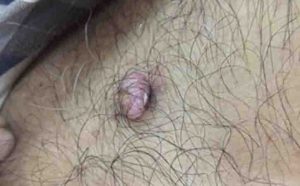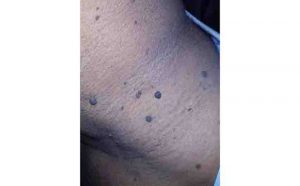Acrochordon
An acrochordon is a small piece of soft, hanging skin that may have a peduncle, or stalk. They can appear anywhere on the body, but especially where skin rubs against other skin or clothing.
Acrochordon also known as cutaneous papilloma, cutaneous tag, fibroepithelial polyp, fibroma molluscum, fibroma pendulum, soft fibroma, and Templeton skin tags.

Acrochordon are benign, noncancerous tumors of the skin. They consist of a core of fibers and ducts, nerve cells, fat cells, and a covering or epidermis. They commonly occur in creases or folds of the skin. They are not dangerous, but they can be removed for aesthetic and cosmetic reasons. Methods of acrochordon removal include: therapies, excision, and cryotherapy.
Acrochordon are very common. It generally occur after midlife. They affect men and women equally.
An acrochordon at first may appear as a tiny soft bump on the skin. Over time, it grows into a flesh-colored piece of skin attached to the skin surface by a stalk. It’s easy to move or wiggle an acrochordon back and forth. An acrochordon is painless, although it can become irritated if it is rubbed a lot.
If an acrochordon is twisted on its stalk, a blood clot can develop within it and the acrochordon may become painful.
Acrochordon may be an external sign of an increased risk of insulin resistance, metabolic syndrome, atherosclerosis and cardiovascular disease.



Acrochordon are made from a protein called collagen and blood vessels, surrounded by a layer of skin. It is unknown what causes them.
Because, usually find tags in skin folds like: armpits, groin, or eyelids, friction from skin rubbing against skin may be involved.
In overweight or obese are more likely to get acrochordon because they have extra skin folds. Hormonal changes during pregnancy can also increase the likelihood of acrochordon forming.
There may be a link between insulin resistance, diabetes, elevated high-sensitive C-reactive protein, a marker of inflammation and acrochordon.
People tend to get more acrochordon as they age. These growths often pop up in middle age and beyond.
Some people appear to inherit an increased susceptibility to acrochordon. It’s possible that certain people inherit an increased likelihood of getting these skin growths. It also associated with some types of human papilloma virus. And also with a sex-steroid imbalance, especially if there are changes in levels of estrogen and progesterone.
As acrochordon are usually harmless, removal is normally for aesthetic or cosmetic reasons.
Large acrochordon, especially in areas where they may rub against something, like: clothing, jewelry or skin, may be removed due to irritation.
Removing a large acrochordon from the face or under the arms can make shaving easier.
Surgery
The following procedures may be used:
- Cauterization: The acrochordon is burned off using electrolysis,
- Cryosurgery: The acrochordon is frozen off using a probe containing liquid nitrogen,
- Ligation: The blood supply to the acrochordon is interrupted,
- Excision: The tag is cut out with a scalpel.
These procedures should only be done by a dermatologist, or specialist skin doctor, or a similarly trained medical professional.
Acrochordon on the eyelid, especially those close to the eyelid margin, may have to be removed by an ophthalmologist, or specialist eye doctor.
Very small tags can be removed by tying dental floss or thin cotton thread around the base of the tag to cut off circulation to the tag.
Other treatments: Cryotheraphy uses extreme cold to freeze the acrochordon, and it will fall off after 7 to 10 days.
To confirm the analyze, need to visit a doctor. When decided to perform surgery, must operate with a consultant. In acrochordon in eyelid, must consult with an ophthalmologists.
- Clinical Dermatology
- Andrew’s Diseases of the skin.
Acrochordon
TUI - Tibot Urgency Index


An acrochordon is a small piece of soft, hanging skin that may have a peduncle, or stalk. They can appear anywhere on the body, but especially where skin rubs against other skin or clothing.
Acrochordon also known as cutaneous papilloma, cutaneous tag, fibroepithelial polyp, fibroma molluscum, fibroma pendulum, soft fibroma, and Templeton skin tags.



Acrochordon are benign, noncancerous tumors of the skin. They consist of a core of fibers and ducts, nerve cells, fat cells, and a covering or epidermis. They commonly occur in creases or folds of the skin. They are not dangerous, but they can be removed for aesthetic and cosmetic reasons. Methods of acrochordon removal include: therapies, excision, and cryotherapy.
Acrochordon are very common. It generally occur after midlife. They affect men and women equally.
An acrochordon at first may appear as a tiny soft bump on the skin. Over time, it grows into a flesh-colored piece of skin attached to the skin surface by a stalk. It’s easy to move or wiggle an acrochordon back and forth. An acrochordon is painless, although it can become irritated if it is rubbed a lot.
If an acrochordon is twisted on its stalk, a blood clot can develop within it and the acrochordon may become painful.
Acrochordon may be an external sign of an increased risk of insulin resistance, metabolic syndrome, atherosclerosis and cardiovascular disease.



Acrochordon are made from a protein called collagen and blood vessels, surrounded by a layer of skin. It is unknown what causes them.
Because, usually find tags in skin folds like: armpits, groin, or eyelids, friction from skin rubbing against skin may be involved.
In overweight or obese are more likely to get acrochordon because they have extra skin folds. Hormonal changes during pregnancy can also increase the likelihood of acrochordon forming.
There may be a link between insulin resistance, diabetes, elevated high-sensitive C-reactive protein, a marker of inflammation and acrochordon.
People tend to get more acrochordon as they age. These growths often pop up in middle age and beyond.
Some people appear to inherit an increased susceptibility to acrochordon. It’s possible that certain people inherit an increased likelihood of getting these skin growths. It also associated with some types of human papilloma virus. And also with a sex-steroid imbalance, especially if there are changes in levels of estrogen and progesterone.
As acrochordon are usually harmless, removal is normally for aesthetic or cosmetic reasons.
Large acrochordon, especially in areas where they may rub against something, like: clothing, jewelry or skin, may be removed due to irritation.
Removing a large acrochordon from the face or under the arms can make shaving easier.
Surgery
The following procedures may be used:
- Cauterization: The acrochordon is burned off using electrolysis,
- Cryosurgery: The acrochordon is frozen off using a probe containing liquid nitrogen,
- Ligation: The blood supply to the acrochordon is interrupted,
- Excision: The tag is cut out with a scalpel.
These procedures should only be done by a dermatologist, or specialist skin doctor, or a similarly trained medical professional.
Acrochordon on the eyelid, especially those close to the eyelid margin, may have to be removed by an ophthalmologist, or specialist eye doctor.
Very small tags can be removed by tying dental floss or thin cotton thread around the base of the tag to cut off circulation to the tag.
Other treatments: Cryotheraphy uses extreme cold to freeze the acrochordon, and it will fall off after 7 to 10 days.
To confirm the analyze, need to visit a doctor. When decided to perform surgery, must operate with a consultant. In acrochordon in eyelid, must consult with an ophthalmologists.
- Clinical Dermatology
- Andrew’s Diseases of the skin.




